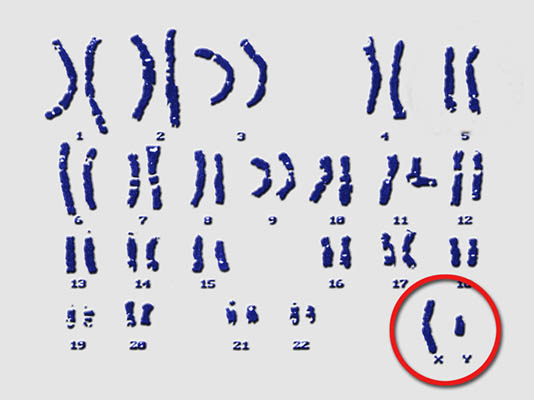The Lanhams of Maryland and the District of Columbia
Molecular Genealogy, the Study of DNA
Part Two: Glossary of Genetic Terms
Compiled by Dr. Howard G. Lanham

Human Male Chromosome Karyotype
©2003 Howard Hughes Medical Institute
The following is a glossary of terms used in genetic research. Understand terminology is always the first step in mastering any field of science.
- Allele
- One of several variants of a gene at a specific site
- Base Pair
- The smallest element of genetic code consisting of a pair of nucleotides of the DNA molecule
- Chromosome
- Structures in the cell nucleus that carry genetic information
- Copy-Number Variants
- Contiguous blocks of DNA that repeat DNA sequences (see-Short Tandem Repeats)
- Dominant
- A single allele, which when paired with a different (heterozygous) one, is able to express its trait preferentially.
- DYS
- This is an abbreviation for DNA from a Y-Chromosome Segment and appears followed by a number as part of the name of a Y-Chromosome locus.
- Karyotype
- A photomicrograph of chromosomes arranged according numbering or other naming convention.
- Genome
- The entire collection of genes possessed by an individual or species.
- Genotype
- The genetic composition of an individual in total or at a specific gene.
- Haplogroup
- A group of similar haplotypes that share a common ancestor with a single nucleotide polymorphism (SNP) mutation. A Haplogroup is specified by a letter of the alphabet and further refined by additional numbers and letters into subcategories.
- Haplotype
- Alleles that occur in proximity on the same chromosome and commonly inherited together
- Heterozygous
- An individual with two different alleles for a gene, one on the paternal derived chromosome and one on the maternal derived chromosome.
- Homozygous
- An individual with two identical alleles for a gene, one on the paternal derived chromosome and one on the maternal derived chromosome.
- Linkage
- The tendency of genes in proximity to be inherited together.
- Linkage Disequilibrium
- The measure of association between genes at different loci, which can be an indicator of their proximity.
- Locus (plural Loci)
- The location on a chromosome at which a gene or other genetic coding sequence can be found.
- Mitochondrial DNA (abbreviation mtDNA)
- Extra-chromosomal DNA found in cell organelles called the mitochondria. Mitochondria exist in the cytoplasm of all living cells and have to do with energy metabolism. All of an individual's mitochondria descend from an original population received from the mother's egg. Mitochondrial DNA can be anyalzed and assigned a Haplogroup, similar to Y-Chromosomal DNA. However, the Haplogroups do not correspond to those of Y-Chromosomal DNA but are unique to mtDNA.
- Multicopy Marker (Multimarker)
- These are markers appearing with a lower case letter designation at the end; for example, DYS 385a and DYS 385b. These are different from single copy markers in that they locate on more than one region on the Y-chromosome. They are also more likely to differ between closely related individuals than single copy markers and will lead to an overestimation of the generational genetic distances between tested individuals using many of the conventional formulas.
- Mutation
- A rare variation of a gene found in less than one percent of a population. (also see polymorphism)
- Nucleotide
- The basic molecular structural subunits of DNA. There are four different DNA nucleotides whose sequence forms the genetic code. Two specific nucleotides form pairs in the DNA molecule called a base pair. A sequence of three nucleotides in a row in the DNA molecule defines a particular amino acid in the structure of a protein molecule made by a particular gene.
- Phenotype
- An observable characteristic of an organism or a trait that is a result of an individual's genotype.
For example, a paint horse is a phenotype.
- Polymorphism
- A variation of a gene (allele) found in greater than one percent of a population. (also see mutation)
- R1b
- A Haplogroup commonly found in Western Europeans and defined by the presence of an M343 single nucleotide polymorphism (SNP).
- R1b1b2
- The most common subclade of Haplogroup R1b that is defined by the presence of both M343 and M269 single nucleotide polymorphisms.
- Recessive
- A trait that is expressed only in a homozygous individual (having two copies of the same gene on male and female derived chromosomes).
- SNP (Single Nucleotide Polymorphism)
- A single point (base pair) alteration of the DNA coding sequence at a particular allele that is a variation of the common or wild type.
- STR (Short Tandem Repeats)
- A repeating sequence of two or more nucleotides that are directly adjacent. In forensics STRs are used to establish the genetic fingerprint of individuals. The value of short tandem repeating sequences are that they are relatively stable even in degraded specimens.
- Subclade
- This is subgroup of a haplogroup and indicated by a series of letters and numbers.
- Variant Allele
- A particular allele variation caused by a SNP that is less common than the most common or wild type.
- Wild Type Allele
- A particular allele variation subject to a SNP that is the most commonly encountered. For example, brown eyes in humans might be called the wild or common type allele while blue or green are variant.
- Y-chromosomal DNA (Y-DNA)
- DNA found on the human Y-Chromosome, which carries genes associated with male sex. All chromosomes exist in pairs except for those having to do with an individual's sex. A male receives a single Y-Chromosome from his father and an X-Chromosome from his mother. A female receives an X-Chromosome from each parent. The genealogical interest in the Y-Chromosome is that it follows a surname and his only inherited from a person's biological father. Y-Chromosome DNA can be analyzed and assigned a Haptogroup.
Introduction Molecular Genealogy
Results of DNA tests on Certain Lanhams
General Introduction to Site
Home
